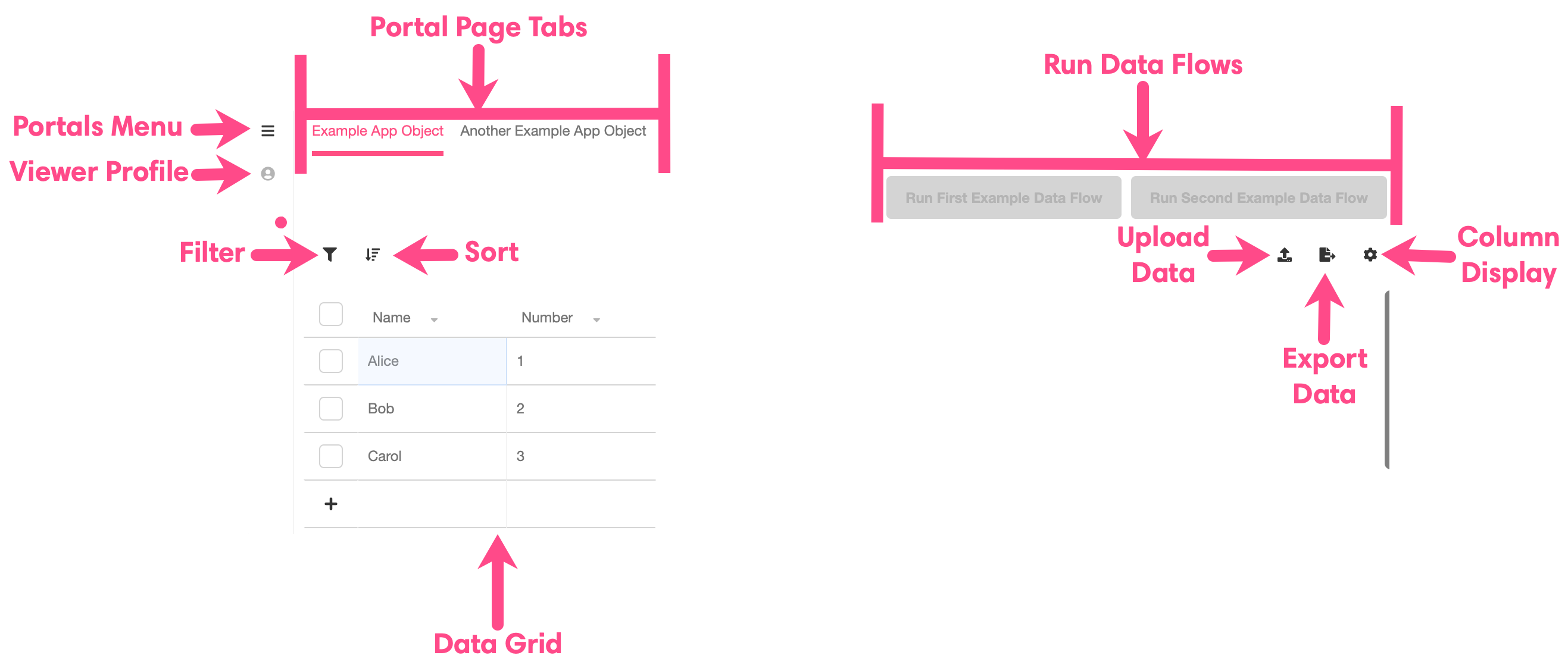Data Grids
Data Grids allow anyone accessing the Portal to interact with data stored in AirData. Each Data Grid is associated with an App Object. By default, a Data Grid displays the data that has been saved to the App Object in exactly the same way that the Stage displays the same information within the AirData Builder. However, it is also possible change or limit exactly which properties of an App Object are displayed; this can be used to make the Data Grid more intuitive to non-developers and to limit the visible information to only that which is relevant to the people who will be regularly accessing the Portal Page. See documentation on the Portals Builder and AirData Builder for more information on how to customize how data is displayed within a Data Grid.
Data Grid Structure
Data Grid Portal Pages are laid out as follows:

Portals Menu
Click the Portals Menu button to select a Portal to open. The Portals available for selection are linked to the role and organization you are signed into.
Viewer Profile
Click on the Viewer Profile Button to view information associated with the account being used to access Portals, including the role and associated email address. This button also provides the option to log out of said account.
Portal Page Tabs
The Portal Page Tabs allow you to toggle between different Portal Pages that are stored under the same Portal. See Portals for a deeper discussion on the difference between Portals and Portal Pages.
Data Grid
A Data Grid displays the data associated with an App Object similiarly to how the data is displayed in AirData. The Data Grid itself is reminiscent of a spreadsheet. Like a spreadsheet, each row represents an instance of an App Object and each column corresponds with a property.
Data Grids also make it possible to select individual instances of App Objects by clicking the check box to their left. Selecting one or more of these boxes make it possible to take actions on the designated App Object instances, such as in the following example, wherein two App Object instances are deleted. Note that the Delete button appears only when a box is checked:
.gif)
Note also that the Run Data Flows buttons changed color when an App Object instance was selected. Why this occurs is touched on below, under Run Data Flows.
Other Buttons
Filter
Click on the Filter button to filter displayed data by specific criteria. Data filtered changes how data is presented in a Data Grid, and what is done by a filter can be easily undone by removing it.
Sort
Click on the Sort button to reorganize rows of data based on the alphanumeric value of specified App Object properties.
Run Data Flows
These buttons, which run Data Flows on selected rows of data, will only be present if they have been created in the Portals Builder. For more on how to add Data Flows to Data Grid, check out Running Data Flows in Portals.
Upload Data
Click on the Upload Data button to append data to the displayed App Object by uploading an appropriately-formatted CSV file.
Export Data
Click on the Export Data button to download information displayed in the Data Grid in a CSV file.
Column Display
Click on the Column Display button to modify what columns are displayed in the Data Grid. Unchecking a column name will not delete any data; it will only render the column temporarily invisible in the Data Grid. Checking an unchecked column name will render it visible again.
Data Grid Capabilities
In addition to allowing Agents to view information stored in AirData, Data Grids also make it easy for Agents to interact with data in various pre-approved ways. For instance, the Portals Builder provides fine control over which object properties Portal viewers will have the capacity to edit and whether or not Portal viewers will be allowed to delete whole rows of data.
One of the most powerful ways Portal viewers can interact with data in a Data Grid is by running Data Flows on select App Object instances. By associating relevant Data Flows to a Data Grid, it's possible to streamline the most common data tasks. There are many possibilities for automation. A simple example involves a Data Grid that displays an App Object containing survey data with a column for email address. A Data Flow can be built that automatically sends follow-up emails to email addresses selected by the Portal viewer. Note that it can perform this Data Flow on any number of App Object instances at a time:
.gif)
Updated 4 months ago